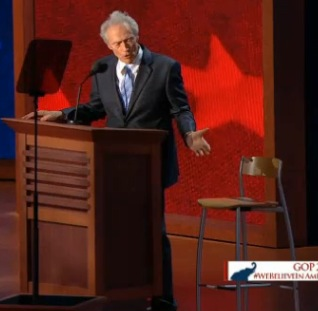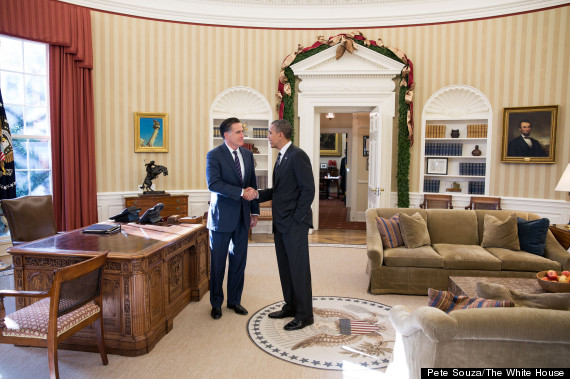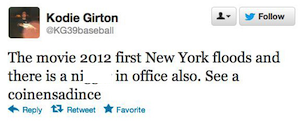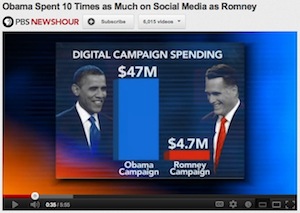
Post-Season Wrap-Up (e)
As with the suddenly prevalent use of the term “optics” to signify the visual appearances of individuals and events in the nation’s political life, this election cycle has marked the introduction of the term “campaign surrogate” or, even more briefly, “surrogate,” to describe people charged with speaking on behalf of a given candidate. This time around, I’ve seen and heard this word applied to everyone from Joe Biden to Chris Christie and Marco Rubio to Ann Romney.
I find this peculiar, especially since our most common usage of the word today occurs in the phrase “surrogate mother,” specifying a woman who carries and gives birth to a child to be raised by others. We also use it in relation to “surrogate court,” where someone legally stands in for a person who for some reason (death, most frequently) can’t represent him- or herself.

Former Gov. Jennifer Granholm, Democratic National Convention, 9-6-12, C-Span, screenshot.
In both usages, the term depersonalizes the surrogate, connoting a necessary but functional substitution in which the personality and motives of the stand-in get submerged and become irrelevant to their official role. And that may hold true with a campaign manager and staff, who serve separately and collectively as mouthpieces for the candidate. But that’s exactly the opposite of how high-profile “campaign surrogates” function.
When Biden or Christie or Rubio or Mrs. Romney or Clint Eastwood (or Michelle Obama or Jennifer Granholm or Bill Clinton or Bruce Springsteen) appear on behalf of candidates they endorse, they’re not neutral, interchangeable cogs. They don’t come onstage as substitute Mitt Romneys or Barack Obamas. Their identity, the public image they’ve crafted and introduced into the collective psyche, is part of the pitch.

Clint Eastwood with chair, RNC, 8-30-12, screenshot.
Indeed, it’s the precise reason they got chosen for that role. It’s their autonomy, their independence, their distinctness, that gives meaning and gravitas to their endorsement and commitment to a particular candidate or cause. That’s true even of candidates’ spouses, whose support of their mates carries more weight if they’re known for speaking their own minds and sometimes having different opinions from their better (or worser) halves.
Members of a movie’s cast with supporting roles aren’t “surrogates” for the leading actors. Players on a sports team who don’t score much but contribute in other ways aren’t “surrogates” for the quarterback and running backs, for the power hitters and starting pitchers. So, like “optics,” “surrogate” isn’t a term I’m going to use. It diminishes the significance of what such figures bring to the contests, and, by misrepresenting it, degrades the language.
Schadenfreude: Served Piping Hot
On November 2, Barack Obama told attendees at a rally in Springfield, Ohio who were booing Mitt Romney’s name to vote instead of booing, because “voting is the best revenge.”

Romney “revenge” ad, November 2012, screenshot.
Grasping at straws, the Romney campaign tried, with no apparent success, to turn this against the president via a last-minute ad, as evidence of his commitment to a supposedly unworthy motive for casting one’s ballot. Yet surely Romney’s insulting disdain for the “47 percent” represents one major reason that tactic failed. I doubt that I’m the first to admit this, but revenge played a role in my own visit to the polls. I’d made my decision long before, of course, but I took vindictive pleasure in watching Romney go down in flames on November 6, and in playing my own small citizenly role in his defeat.
While they say revenge is a dish best eaten cold, schadenfreude is best served piping hot. Obama quickly arranged to scarf down a plateful fresh out of the oven. And he set it up so as to share that treat with all of the “47 percent,” plus any others who’ve come to reject and despise Mitt Romney.

Barack Obama with Mitt Romney, Oval Office, 11-29-12. Official White House photo by Pete Souza.
I’m talking about Obama’s “private lunch” with Romney at the White House on Thursday, November 29, ostensibly to provide the Obama administration with the Mittster’s sage advice on matters economic. Even before it happened, the very public announcement of the president-elect’s intention to issue this invitation salted the raw wound of Romney’s trouncing at his hands. Can you visualize anything more humiliating for Romney than a formal meeting with the president-elect he advised, on April 16 of this year, to “start packing”? How ignominious.
Romney couldn’t possibly have turned down that invite. Not only would it have represented the height of rudeness to do so, it would have been exceedingly impolitic. Beyond that, with his reputation shredded and his leadership of the GOP suddenly vanished, he needs any credibility he can get in the political sector. So he went, because he had to, and everyone knew it.

White House place setting
Obama of course greeted him in the Oval Office at the White House, both of which Romney aspired to, and considered himself entitled to, but will never occupy as more than a transient visitor. Protocol required him to address Obama as “Mr. President,” the title Romney coveted, denied to him by the majority of the American people and the superior political savvy of Obama.
Obama manifested his wonderfully polished social and diplomatic skills, acting the consummate host, treating Romney to a one-on-one sit-down lunch, and POTUS asked the loser for his ideas on how to fix the economy and improve relations with the business sector and reach across the aisle.

Jon_Stewart, The Daily Show, Obama-Romney lunch, 11-3-12, screenshot.
Romney doubtless delivered his usual bromides and nostrums, to which Obama listened in respectful silence. Then Romney posed for a grip-and-grin before taking his leave. That’s the last he’s likely to see of the inside of the White House, unless he and the family sign up for the public tour. Jon Stewart at The Daily Show nailed the deliciousness of the situation in a bit the next day.
Romney hated every second of it, I guarantee. I can envision a floor covered with the fine powder of tooth grindings upon his departure. And Obama relished it, as did I and many I know, and many more I don’t. Yes, I have a mean bone in my body, and it doesn’t bother me that the president-elect does too (though I don’t expect him to cop to it). The official photo of that event means a lot to me, therefore — especially as I’m sure the White House will send Romney a print for his own archive, signed by the President, as a souvenir of the occasion.
Republicans and the Monkey Trap

Election 2012 tweet from Kodie Girton, 11-6-12.
While the Obamas settle back in at the White House, and Mitt Romney pisses on everyone’s heads while telling them it’s raining, the Republic Party has to resolve its quandary: How can they persuade the majority of American voters that they’re not a haven for uneducated racist bumpkins while still holding on to their uneducated racist bumpkin base?
This dilemma constitutes a version of the classic monkey trap. To catch a monkey in India, you use a bottle anchored to the ground, with a neck just wide enough for the monkey’s empty paw to pass through. Then you put a small banana in the bottle and wait. A monkey will grab the banana and, refusing to let it go, will get caught. (Here’s a video of a variant.)
Garbage In, Garbage Out

PBS News Hour, “Daily Download,” 11-16-12, screenshot.
In a piece in the National Journal about the right wing’s incompetence at polling and poll analysis and social media, editor in-chief Reid Wilson writes, “Democrats ‘must be looking at us like we’re the biggest f—– morons in the world,’ one frustrated Republican said.” You got that right, pal.
And because that’s how we see you, let me spell out the lesson plainly: The Republic Party is the monkey. Its base is the banana. This election was the bottle. There’s another election in 2014, and another two years later, and another two years further on. You’ll find the same banana in the same bottle each time.
And the base isn’t exactly au courant with new technology. After all, as Bill O’Reilly said so poignantly, they’ve just now realized that the world of Leave It to Beaver has gone for good. (Don’t confuse them even further by telling them that world never existed in the first place.)

Map of site of Peggy Noonan’s gut feelings and vibrations.
Consider these statistics: Compared to the 2008 campaign, the Obama campaign spent three times as much on social media this time around ($47 million versus $16 million). And they spent ten time as much this time as the Romney campaign did: $47 million versus $4.7 million. That fact alone suggests why the right lost big: They don’t get the 21st century. For that matter, they didn’t get the second half of the last one. That’s why they’ll listen to Peggy Noonan’s vaporous “gut feelings” and “vibrations” while deriding Nate Silver’s algorithms — reading chicken entrails while dismissing mathematical analysis as “voodoo statistics.”
 The Republic Party’s loss on November 6 traces to the fact that its aging leadership has little experience with or interest in the new digital communication technologies, and its aging base has little involvement with those technologies. Barack Obama’s just 14 years younger than Mitt Romney, but he’s at least two generations hipper to visual communication and new media. (Not that this is inherently an age thing; I’m 4-1/2 years older than Romney, and I could give him pointers on those subjects.)
The Republic Party’s loss on November 6 traces to the fact that its aging leadership has little experience with or interest in the new digital communication technologies, and its aging base has little involvement with those technologies. Barack Obama’s just 14 years younger than Mitt Romney, but he’s at least two generations hipper to visual communication and new media. (Not that this is inherently an age thing; I’m 4-1/2 years older than Romney, and I could give him pointers on those subjects.)

Election 2012 tweet from “Country Boy,” 11-6-12.
That confronts the neocons with yet another quandary, this one not a monkey trap but a catch-22. In order to attract younger voters to the Republic Party they need to embrace the internet and social media, so as to present a media-savvy image to those prospects.
But to create that updated technological presence, they need a cohort of young tech geeks and nerds not presently within their ranks; and the microculture out of which those experts emerge is an open-source, Creative Commons, “information wants to be free” environment that doesn’t much overlap Republican values, with their higher-education-is-for-snobs mentality, their anti-science positions, and their “creationist/intelligent design” nonsense. (See “The Rise of the Creative Class” by Richard Florida, from May 2002, at the Washington Monthly, for more on this.)

Election 2012 tweet from “Britt D,” 11-6-12.
Of course they can throw money at this problem, offering higher salaries and other perks to hip young programmers, social-media mavens, web designers, and others — while know-nothings like Stuart Stevens, chief strategist for the Romney-Ryan campaign, trivializes the impact of “television ads [and] whiz-bang turnout technologies.” Good luck with that. Meanwhile, the Democrats have established such a lead on that front that it’ll take three or four elections before the playing field gets level in that regard, if it ever does.
•
For an index of links to all posts related to this story, click here.
•
This post supported by a donation from the Estate of Lyle Bongé.
Election 2012: Image World (17)
Post-Season Wrap-Up (e)
As with the suddenly prevalent use of the term “optics” to signify the visual appearances of individuals and events in the nation’s political life, this election cycle has marked the introduction of the term “campaign surrogate” or, even more briefly, “surrogate,” to describe people charged with speaking on behalf of a given candidate. This time around, I’ve seen and heard this word applied to everyone from Joe Biden to Chris Christie and Marco Rubio to Ann Romney.
I find this peculiar, especially since our most common usage of the word today occurs in the phrase “surrogate mother,” specifying a woman who carries and gives birth to a child to be raised by others. We also use it in relation to “surrogate court,” where someone legally stands in for a person who for some reason (death, most frequently) can’t represent him- or herself.
Former Gov. Jennifer Granholm, Democratic National Convention, 9-6-12, C-Span, screenshot.
In both usages, the term depersonalizes the surrogate, connoting a necessary but functional substitution in which the personality and motives of the stand-in get submerged and become irrelevant to their official role. And that may hold true with a campaign manager and staff, who serve separately and collectively as mouthpieces for the candidate. But that’s exactly the opposite of how high-profile “campaign surrogates” function.
When Biden or Christie or Rubio or Mrs. Romney or Clint Eastwood (or Michelle Obama or Jennifer Granholm or Bill Clinton or Bruce Springsteen) appear on behalf of candidates they endorse, they’re not neutral, interchangeable cogs. They don’t come onstage as substitute Mitt Romneys or Barack Obamas. Their identity, the public image they’ve crafted and introduced into the collective psyche, is part of the pitch.
Clint Eastwood with chair, RNC, 8-30-12, screenshot.
Indeed, it’s the precise reason they got chosen for that role. It’s their autonomy, their independence, their distinctness, that gives meaning and gravitas to their endorsement and commitment to a particular candidate or cause. That’s true even of candidates’ spouses, whose support of their mates carries more weight if they’re known for speaking their own minds and sometimes having different opinions from their better (or worser) halves.
Members of a movie’s cast with supporting roles aren’t “surrogates” for the leading actors. Players on a sports team who don’t score much but contribute in other ways aren’t “surrogates” for the quarterback and running backs, for the power hitters and starting pitchers. So, like “optics,” “surrogate” isn’t a term I’m going to use. It diminishes the significance of what such figures bring to the contests, and, by misrepresenting it, degrades the language.
Schadenfreude: Served Piping Hot
On November 2, Barack Obama told attendees at a rally in Springfield, Ohio who were booing Mitt Romney’s name to vote instead of booing, because “voting is the best revenge.”
Romney “revenge” ad, November 2012, screenshot.
Grasping at straws, the Romney campaign tried, with no apparent success, to turn this against the president via a last-minute ad, as evidence of his commitment to a supposedly unworthy motive for casting one’s ballot. Yet surely Romney’s insulting disdain for the “47 percent” represents one major reason that tactic failed. I doubt that I’m the first to admit this, but revenge played a role in my own visit to the polls. I’d made my decision long before, of course, but I took vindictive pleasure in watching Romney go down in flames on November 6, and in playing my own small citizenly role in his defeat.
While they say revenge is a dish best eaten cold, schadenfreude is best served piping hot. Obama quickly arranged to scarf down a plateful fresh out of the oven. And he set it up so as to share that treat with all of the “47 percent,” plus any others who’ve come to reject and despise Mitt Romney.
Barack Obama with Mitt Romney, Oval Office, 11-29-12. Official White House photo by Pete Souza.
I’m talking about Obama’s “private lunch” with Romney at the White House on Thursday, November 29, ostensibly to provide the Obama administration with the Mittster’s sage advice on matters economic. Even before it happened, the very public announcement of the president-elect’s intention to issue this invitation salted the raw wound of Romney’s trouncing at his hands. Can you visualize anything more humiliating for Romney than a formal meeting with the president-elect he advised, on April 16 of this year, to “start packing”? How ignominious.
Romney couldn’t possibly have turned down that invite. Not only would it have represented the height of rudeness to do so, it would have been exceedingly impolitic. Beyond that, with his reputation shredded and his leadership of the GOP suddenly vanished, he needs any credibility he can get in the political sector. So he went, because he had to, and everyone knew it.
White House place setting
Obama of course greeted him in the Oval Office at the White House, both of which Romney aspired to, and considered himself entitled to, but will never occupy as more than a transient visitor. Protocol required him to address Obama as “Mr. President,” the title Romney coveted, denied to him by the majority of the American people and the superior political savvy of Obama.
Obama manifested his wonderfully polished social and diplomatic skills, acting the consummate host, treating Romney to a one-on-one sit-down lunch, and POTUS asked the loser for his ideas on how to fix the economy and improve relations with the business sector and reach across the aisle.
Jon_Stewart, The Daily Show, Obama-Romney lunch, 11-3-12, screenshot.
Romney doubtless delivered his usual bromides and nostrums, to which Obama listened in respectful silence. Then Romney posed for a grip-and-grin before taking his leave. That’s the last he’s likely to see of the inside of the White House, unless he and the family sign up for the public tour. Jon Stewart at The Daily Show nailed the deliciousness of the situation in a bit the next day.
Romney hated every second of it, I guarantee. I can envision a floor covered with the fine powder of tooth grindings upon his departure. And Obama relished it, as did I and many I know, and many more I don’t. Yes, I have a mean bone in my body, and it doesn’t bother me that the president-elect does too (though I don’t expect him to cop to it). The official photo of that event means a lot to me, therefore — especially as I’m sure the White House will send Romney a print for his own archive, signed by the President, as a souvenir of the occasion.
Republicans and the Monkey Trap
Election 2012 tweet from Kodie Girton, 11-6-12.
While the Obamas settle back in at the White House, and Mitt Romney pisses on everyone’s heads while telling them it’s raining, the Republic Party has to resolve its quandary: How can they persuade the majority of American voters that they’re not a haven for uneducated racist bumpkins while still holding on to their uneducated racist bumpkin base?
This dilemma constitutes a version of the classic monkey trap. To catch a monkey in India, you use a bottle anchored to the ground, with a neck just wide enough for the monkey’s empty paw to pass through. Then you put a small banana in the bottle and wait. A monkey will grab the banana and, refusing to let it go, will get caught. (Here’s a video of a variant.)
Garbage In, Garbage Out
PBS News Hour, “Daily Download,” 11-16-12, screenshot.
In a piece in the National Journal about the right wing’s incompetence at polling and poll analysis and social media, editor in-chief Reid Wilson writes, “Democrats ‘must be looking at us like we’re the biggest f—– morons in the world,’ one frustrated Republican said.” You got that right, pal.
And because that’s how we see you, let me spell out the lesson plainly: The Republic Party is the monkey. Its base is the banana. This election was the bottle. There’s another election in 2014, and another two years later, and another two years further on. You’ll find the same banana in the same bottle each time.
And the base isn’t exactly au courant with new technology. After all, as Bill O’Reilly said so poignantly, they’ve just now realized that the world of Leave It to Beaver has gone for good. (Don’t confuse them even further by telling them that world never existed in the first place.)
Map of site of Peggy Noonan’s gut feelings and vibrations.
Consider these statistics: Compared to the 2008 campaign, the Obama campaign spent three times as much on social media this time around ($47 million versus $16 million). And they spent ten time as much this time as the Romney campaign did: $47 million versus $4.7 million. That fact alone suggests why the right lost big: They don’t get the 21st century. For that matter, they didn’t get the second half of the last one. That’s why they’ll listen to Peggy Noonan’s vaporous “gut feelings” and “vibrations” while deriding Nate Silver’s algorithms — reading chicken entrails while dismissing mathematical analysis as “voodoo statistics.”
Election 2012 tweet from “Country Boy,” 11-6-12.
That confronts the neocons with yet another quandary, this one not a monkey trap but a catch-22. In order to attract younger voters to the Republic Party they need to embrace the internet and social media, so as to present a media-savvy image to those prospects.
But to create that updated technological presence, they need a cohort of young tech geeks and nerds not presently within their ranks; and the microculture out of which those experts emerge is an open-source, Creative Commons, “information wants to be free” environment that doesn’t much overlap Republican values, with their higher-education-is-for-snobs mentality, their anti-science positions, and their “creationist/intelligent design” nonsense. (See “The Rise of the Creative Class” by Richard Florida, from May 2002, at the Washington Monthly, for more on this.)
Election 2012 tweet from “Britt D,” 11-6-12.
Of course they can throw money at this problem, offering higher salaries and other perks to hip young programmers, social-media mavens, web designers, and others — while know-nothings like Stuart Stevens, chief strategist for the Romney-Ryan campaign, trivializes the impact of “television ads [and] whiz-bang turnout technologies.” Good luck with that. Meanwhile, the Democrats have established such a lead on that front that it’ll take three or four elections before the playing field gets level in that regard, if it ever does.
•
For an index of links to all posts related to this story, click here.
•
This post supported by a donation from the Estate of Lyle Bongé.